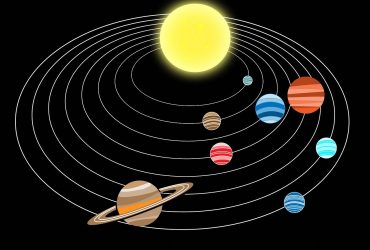Some Interesting Facts About Mercury (The Swift Planet) For Kids
Mercury is basically the closest planet to the Sun and also the most heavily cratered bodies in the solar system. Life on its surface is nearly impossible due to the alternately extreme variation of temperatures. Let’s take a look at some interesting facts about the “Swift Planet” for kids.
What does it look like from Earth?
Although Mercury – which looks like a small and bright dot in the western or eastern sky – is in such proximity to the Sun, people on Earth can only spot it several times a year. These occur at times when this planet is at the farthest position from the Sun in its orbit.
In general, the best time that you can observe Mercury is just before the sunrise when the planet is at the “greatest western elongation” or just after the sunset when it is at the “greatest eastern elongation.” It is advisable to avoid looking at it when the Sun already rises.
Day and year on Mercury
It takes Mercury approximately 88 days to travel around its orbit around the Sun, which is around 58 million kilometres. That’s why it is often known as the Swift Planet. The closest and farthest distance to the Sun is 46 million and 70 million kilometres respectively. This proximity and orbit give the planet the coldest and hottest surface temperatures in the solar system.
Mercury rotates very slowly around its axis, with nearly 60 days to complete a round. For every 2 trips around the Sun, this planet spins three times. An effect of this position is that a day on Mercury is equivalent to 176 days on Earth.
From icy to dry, cold to hot
The surface temperatures on Mercury are extreme because of its slow spin around the axis and short year. The close distance to the Sun also makes many areas get frozen in the dark while other areas get very hot. On a particular day, the temperatures would be as high as 370 degrees and as low as 30 degrees. Only Venus has a higher level due to its cloud-covered surface.
Atmosphere
Mercury has nearly no atmosphere because the surface is too hot and small to retain any air. Instead, the planet has what is known as the exosphere, a weak combination of various atoms such as potassium, sodium, oxygen, helium, hydrogen, and calcium.
It appears and disappears when the solar wind sweeps throughout the surface. Some areas of the exosphere might also be originated from the surface itself as radioactive components inside the structure decompose and decay and release these chemical elements.
Structure and size
Mercury is the second smallest planet in the Solar System, before Pluto. Its equator lasts approximately 15,300 kilometres, which is even smaller than Titan – the largest moon of Saturn and Ganymede – the moon of Jupiter.
The total amount of materials or mass of Mercury is around 0.055 Earths. Nearly 70% of its structure contains metallic like iron, and the remaining 30% is silicates, a type of rock mostly made of silicon. The core, which is mainly comprised of liquid iron, is around 55% of the total volume. When the planet rotates around its spins, the liquid core also moves around and produces a magnetic field.
Surface
The typical surface on Mercury is dark grey, which is covered with a layer of carbon dust resulted from billions of impact years. Indeed, this planet is one of the most severely cratered celestial bodies in the Solar System.
Images provided by spacecraft have shown that Mercury’s surface is heavily bombarded with meteors. The craters are available in all sizes and shapes, which suggests impacts from both small and large space debris.
The volcanic plains appeared millions of years ago when lava came out from under the surface. There are also a few curious-looking wrinkle ridges and cracks. They are produced when the planet started to cool during the creation.
Mercury explorations
Due to the proximity to the Sun, it is extremely challenging to explore Mercury. Ground-based telescopes only show a few things about its phases.
The first spacecraft to Mercury was launched in 1974. The Mariner 10 carried cameras and instruments and transmitted the first-ever data and pictures from this planet. Data from this trip helped scientists plan for the next one, called the MESSENGER. This spacecraft approached the planet from 2011 to 2015. The collected images and data revealed many facts about the structure and surface of Mercury.
The next mission to Mercury will be the BepiColumbo in 2025, a cooperation between the Japanese and EU space agency.



